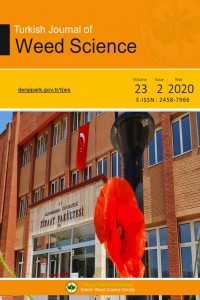Tokat İlinde Yağlık Ayçiçeği (Helianthus annuus L.) Yetiştiriciliğinde Yabancı Ot Kontrolü İçin Kritik Periyodun Belirlenmesi
Abstract
Dünyada ekimi ve üretimi en fazla yapılan yağlı tohumlu bitki soya bitkisi iken ülkemizde ayçiçeği (Helianthus annuus L.) ekimi ve üretimi en fazla yapılan yağlı tohumlu bitkidir. Yağlık ayçiçeği yetiştiriciliğinde en önemli sorunlardan biri, birim alandan elde edilen üründe önemli kayıplara neden olan yabancı otlardır. Bugün dünyada ve ülkemizde yabancı otlarla mücadelede mekanik, kültürel ve kimyasal mücadele metotlarının birlikte düşünülerek oluşturulacak “Entegre Mücadele Programlarına” ihtiyaç vardır. Bu tip programların geliştirilebilmesi için de hedef yabancı otların ekonomik zarar eşiklerinin, kritik periyotlarının ve topraktaki mevcut tohum rezervlerinin bilinmesi ve buna bağlı olarak da erken uyarı kriterlerinin tespit edilmesi gerekmektedir. Yağlık ayçiçeğinde yabancı otlarla en uygun mücadele döneminin (kritik periyot) belirlenmesi amacıyla Tokat İlinde 2014-2016 yıllarında 3 yıl boyunca yürütülen bu çalışmada; denemenin ilk yılında (2014) kritik periyot 2. ile 10. haftalar arası, ikinci yıl (2015) 4. ile 6. haftalar arası ve üçüncü yıl (2016) 4,5. hafta ile 8. haftalar arası olarak tespit edilmiştir. Her üç yılda da belirlenen kritik periyot dönemleri arasındaki farklılığın ayçiçeğinin yetişme dönemlerindeki farklı yağış rejimlerinden kaynaklandığı düşünülmektedir. Bu nedenle uzun yıllar yağış ortalamaları dikkate alınarak yapılan değerlendirme neticesinde çalışmanın ikinci yılındaki yağış ve sıcaklık ortalamalarının uzun yıllar ortalamasına daha yakın olduğu tespitinden hareketle ayçiçeğinde yabancı otlarla mücadelede en uygun dönemin 4. hafta ile 6. hafta arası olduğu kanaatine varılmıştır.
Keywords
Supporting Institution
TAGEM
Project Number
TAGEM-BS-13/04-01/04-09
References
- Referans1. Anonim, 2019. http://www.tuik.gov.tr Referans2. Çoruh, İ. Ve Zengin, H., (2009). Ayçiçeği (Helianthus annuus L.)’ nde yabancı ot kontrolü için kritik periyodun belirlenmesi. Türkiye III. Bitki koruma Kongresi, 15- 18 Temmuz 2009, Van. Referans3. Demirören T., (1978). Tokat’ta Ayçiçeği Su Tüketiminin Saptanması. Tarım ve Kooperatifler Bakanlığı, Topraksu Genel Müdürlüğü, Tokat Bölge Toprak Su Araştırma Enstitüsü Müdürlüğü Yayınları, Yayın No: 25, 23s. Referans4. Hall, M.R., Swanton, C. And Glenn, W.A., (1992). The critical period of Weed Control İn grain corn (Zea mays L.). Weed Sci., 40-441-447. Referans5. Noyan, Ö.F.,Demir, M., (1997). Tokat ve Amasya Yöreleri Sulu Koşullarında Ayçiçeğinin Azotlu ve Fosforlu Gübre İsteği. Toprak ve Su Kaynakları Araştırma Enstitüsü Yıllığı, Yayın No: 106, 393-394s. Referans6. Özkil, M., Torun, H., Eymirli, S., Üremiş, İ., Tursun, N., (2019). Ayçiçeği (Helianthus Annuus L.) Ekim Alanlarında Yabancı Ot Kontrolü için Kritik Periyot Zamanının Belirlenmesi. 6. Uluslararası Multidisipliner Çalışmaları Kongresi. 26-27 Nisan 2019, Gaziantep. Referans7. Tursun, N., Bukun B., Karacan S.C., Ngouajio M. And Mennan H., (2007). Critical period for weed control in leek (Allium porrum L.). HortScience, 42(1):106-109.
Determination of the Critical Period for Weed Control in Oil Sunflower (Helianthus annuus L.) Cultivation in Tokat Province
Abstract
While soybean plant is the most cultivated and produced oilseed plant in the world, sunflower in our country. One of the most important problems in oil sunflower cultivation is weeds that cause significant losses in product obtained per unit area. Today, there is a need for "Integrated Management Programs" which will be formed by considering mechanical, cultural and chemical struggle methods in struggle with weeds in our country and in the world. In order to develop such programs, the economic damage thresholds of the target weeds, the critical periods and the seed reserves existing in the soil must be known and the early warning criteria must be accordingly determined. In this study, conducted during three years (2014-2016) in order to determine the most suitable control period (critical period) with weeds in oiled sunflower is determined between the 2nd and 10th weeks in the first year (2014), between 4th and 6th weeks in the second year (2015) and between 4th and 10th weeks in the third year (2016) of the experiment in Tokat province. Due to different precipitation regimes in growing periods of sunflower of the difference between critical period cycles determined in every three years are thought. For this reason, it has been concluded that the most suitable period for struggling with weeds in the sunflower is between the 4th week and the 6th week, based on the determination that the rainfall and temperature averages in the second year are closer to the average for long years.
Keywords
Project Number
TAGEM-BS-13/04-01/04-09
References
- Referans1. Anonim, 2019. http://www.tuik.gov.tr Referans2. Çoruh, İ. Ve Zengin, H., (2009). Ayçiçeği (Helianthus annuus L.)’ nde yabancı ot kontrolü için kritik periyodun belirlenmesi. Türkiye III. Bitki koruma Kongresi, 15- 18 Temmuz 2009, Van. Referans3. Demirören T., (1978). Tokat’ta Ayçiçeği Su Tüketiminin Saptanması. Tarım ve Kooperatifler Bakanlığı, Topraksu Genel Müdürlüğü, Tokat Bölge Toprak Su Araştırma Enstitüsü Müdürlüğü Yayınları, Yayın No: 25, 23s. Referans4. Hall, M.R., Swanton, C. And Glenn, W.A., (1992). The critical period of Weed Control İn grain corn (Zea mays L.). Weed Sci., 40-441-447. Referans5. Noyan, Ö.F.,Demir, M., (1997). Tokat ve Amasya Yöreleri Sulu Koşullarında Ayçiçeğinin Azotlu ve Fosforlu Gübre İsteği. Toprak ve Su Kaynakları Araştırma Enstitüsü Yıllığı, Yayın No: 106, 393-394s. Referans6. Özkil, M., Torun, H., Eymirli, S., Üremiş, İ., Tursun, N., (2019). Ayçiçeği (Helianthus Annuus L.) Ekim Alanlarında Yabancı Ot Kontrolü için Kritik Periyot Zamanının Belirlenmesi. 6. Uluslararası Multidisipliner Çalışmaları Kongresi. 26-27 Nisan 2019, Gaziantep. Referans7. Tursun, N., Bukun B., Karacan S.C., Ngouajio M. And Mennan H., (2007). Critical period for weed control in leek (Allium porrum L.). HortScience, 42(1):106-109.
Details
| Primary Language | Turkish |
|---|---|
| Subjects | Agricultural Engineering |
| Journal Section | Research Article |
| Authors | |
| Project Number | TAGEM-BS-13/04-01/04-09 |
| Publication Date | December 31, 2020 |
| Acceptance Date | September 7, 2020 |
| Published in Issue | Year 2020 Volume: 23 Issue: 2 |



